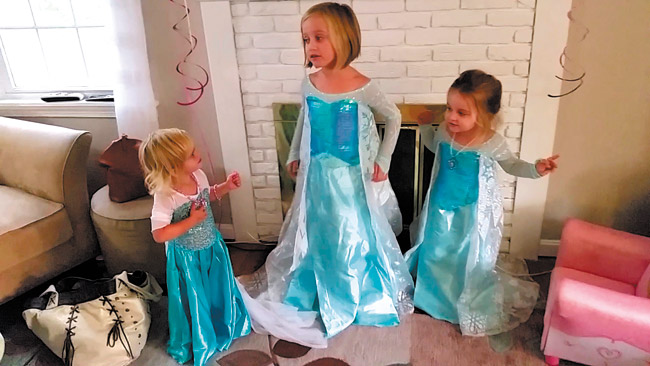Trying To ‘Let It Go’ In ‘Frozen’ Virginia
Upon reflection, I’ve concluded that my recent Halloween visit with our three granddaughters (ages 2, 3 and 6) in Northern Virginia couldn’t have ended any other way for me: catching a wretched cold and awakening to the fact that generation gaps are largely exaggerated.
Frozen turned out to be the theme for the week, as you would know if you’ve been around any girl child over the past six months. Our bubbly trio of trick-or-treaters predictably dressed as Elsa, the ice-cursed but headstrong queen from Disney’s most popular film since Snow White. (Disney reports 3 million Frozen costumes sold).
Adults such as I also love the movie, which definitely is headed for classic status. But my favorite character isn’t the self-centered, imperious Elsa, but the loyal, endearing, yet impulsive sister, Anna. So I asked the 6-year-old, “Why didn’t you want to be Anna?” Her answer made me realize that not much has changed since the 1950s when I saw Cinderella: Elsa was prettier, had the prettiest dress and sang the prettiest song.
In 2014, little girls like “pretty” the same as they did in 1950.
I honestly hadn’t realized the impact Frozen had made on little girls until the shimmery, ice-blue gowns with long, flowing trains came out of the off-limits place my daughter had them hidden. Six big eyes suddenly turned into pies. Six jumping feet became manic. They were possessed.
Then, I’ve found, that the movie’s breakout single, Let it Go, is so captivating that it is sung worldwide — even by babies who haven’t yet learned to talk or walk. (I have witnessed this phenomenon in airports from Ethiopia to Los Angeles.) In fact, after a week of hearing Let it Go sung from every coffee table, bathtub, crib and ottoman in my daughter’s house, the tune permanently will loop through my head until death finally relieves me. A self-diagnosis reveals that I’ve been “Elsa’d.” You also may suffer from this not-yet-medically-recognized condition.
The Elsa syndrome also may be related to cold weather, but more so it’s because all of my little Elsas were fighting off the traditional Halloween sniffles caused by a seasonal sugar overdose and the germ-incubation space better known as a classroom.
Just before the costume parade, the 2-year-old decided she didn’t want to wear a jacket over her Elsa costume, fully living the Let it Go lyric, “It’s time to see what I can do, to test the limits and break through. No right, no wrong, no rules for me. I’m free!”
It was 45 degrees with a 35 degree wind-chill factor, but I reminded myself of lesson one in the grandmother handbook: Give a grandchild her way. It didn’t take long before she realized she wasn’t Elsa because the cold did bother her anyway.
Nonetheless, after the Halloween parade, at which we all came down with pneumonia, imagine this: The girls wanted to watch Frozen. It was my fifth viewing, but this time I decided to analyze the story, and here’s what I know: There was no handsome prince to save the day with a kiss, because we all know that Cinderella and Snow White damaged women for generations, leaving them unable to achieve equal pay and reproductive rights. The bad and not-so-bright people in Frozen are all men. Even Olaf, the snowman.
So anyway, I asked the 3-year-old, “What is your favorite part in Frozen?”
“When Kristoff kisses Anna,” she giggled. Then she asked, “Can we watch Cinderella now, Mimi?”
susanpagecoffee@gmail.com






